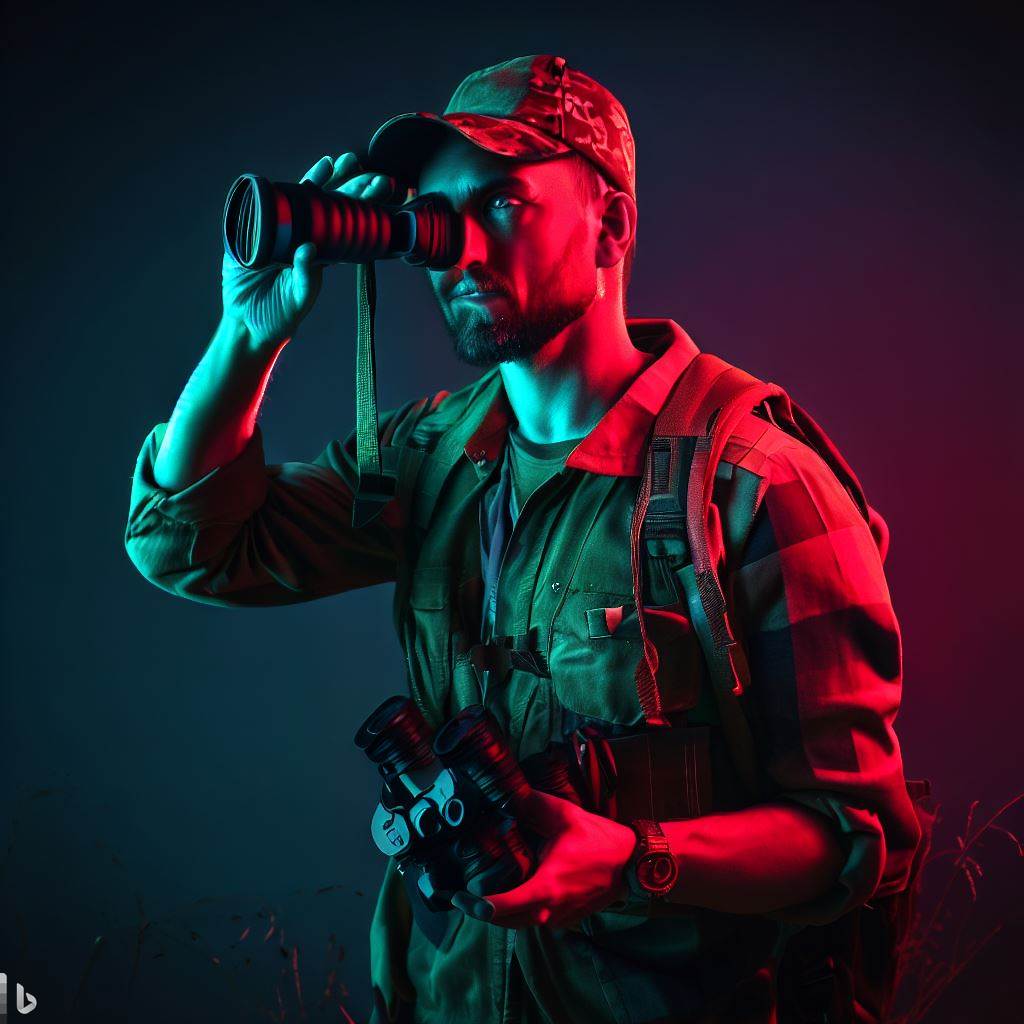

In the world of military operations, the use of technology plays a crucial role in enhancing soldiers’ capabilities and ensuring their safety. One such technology that has revolutionized military night vision hunting is thermal imaging.
By harnessing the power of heat signatures, thermal imaging allows soldiers to detect and identify targets even in complete darkness. This article explores the indispensable role of thermal imaging in military night vision hunting and how it has become an invaluable tool for successful operations in challenging environments.
Understanding Thermal Imaging
Definition Of Thermal Imaging
Thermal imaging is a technology that allows us to visually capture and display the radiant heat emitted by objects and living beings. It utilizes specialized cameras that detect and convert infrared energy into a visible image, enabling us to see and interpret temperature variations in our surroundings.
How Thermal Imaging Works
Thermal imaging works on the principle of detecting differences in temperature. The camera’s sensors pick up the heat radiating from objects, converting it into electrical signals. These signals are then processed and translated into a visual representation, usually in the form of a color gradient or black-and-white image.
The hotter an object is, the brighter or more intense it appears in the thermal image. This technology enables us to see beyond the limitations of our human vision, especially in low-light or obscured conditions.
Applications Of Thermal Imaging In Various Industries
Thermal imaging technology finds applications in a wide range of industries. In the medical field, it can be used to detect diseases or injuries by analyzing differences in temperature patterns in the body. In construction and building inspections, it can identify heat leaks, electrical faults, or plumbing issues.
Firefighters employ thermal imaging to locate hotspots and missing persons in smoke-filled environments. Additionally, it has proven to be invaluable in law enforcement, search and rescue operations, and energy auditing.
Night Vision Technology


Introduction To Night Vision Technology
Night vision technology allows us to see in low-light or no-light situations. It enhances our visibility by amplifying the available light or by capturing the infrared light spectrum that is beyond our regular vision. This technology has evolved significantly over the years, providing us with the ability to navigate and carry out various tasks in darkness.
Evolution Of Night Vision Technology
Night vision technology has come a long way since its inception. Initially developed for military purposes, it has gradually become more accessible and applicable to civilian use. From early image intensification devices that rely on existing light sources to the latest thermal imaging technology, advancements have allowed for greater resolution, range, and versatility.
Different types of night vision devices
Night vision devices come in various forms, each with its own mechanisms for enhancing visibility in the dark. Image intensifiers amplify the available light, allowing us to see objects that are otherwise difficult to detect. Thermal imaging devices, on the other hand, capture the infrared energy emitted by objects to create a visual representation based on temperature differences. Both technologies serve different purposes and have their unique advantages.
Overview Of Military Night Vision Hunting
Purpose And Objectives Of Military Night Vision Hunting
Military night vision hunting serves several important purposes. It allows military personnel to operate covertly during low-light conditions, gaining a tactical advantage over their adversaries. It enables effective surveillance and reconnaissance, as well as the detection of potential threats or concealed enemy positions. By incorporating night vision technology, military forces can enhance their capabilities and increase mission success rates.
Tactical Advantages Of Hunting In Low-Light Conditions
Hunting in low-light conditions provides significant tactical advantages for military operations. The element of surprise is heightened as visibility is reduced, making it harder for potential threats to detect the presence of military forces.
In addition, it allows troops to move undetected, gather intelligence, and perform critical tasks with a decreased risk of detection or interference.
Importance Of Effective Surveillance And Reconnaissance
Effective surveillance and reconnaissance are crucial in military operations. The ability to gather real-time intelligence, monitor enemy activities, and assess the situation accurately can greatly influence the outcome of a mission.
Night vision technology, when integrated with thermal imaging, enhances this capability by providing clear visual information and enabling extended surveillance in low-light environments.
Thermal Imaging In Military Night Vision Hunting
Integration Of Thermal Imaging With Night Vision Technology
Integrating thermal imaging with night vision technology provides military personnel with a comprehensive solution for hunting in low-light conditions. By combining the ability to detect heat signatures with enhanced visibility in the dark, soldiers gain a significant advantage. Thermal imaging can be overlayed on night vision goggles or cameras, allowing for a seamless fusion of both technologies.
Enhancing Situational Awareness And Target Detection
Thermal imaging greatly enhances situational awareness by revealing heat signatures that are invisible to the naked eye. It enables military personnel to detect and identify potential threats, even in total darkness or obscured environments. This information assists in decision-making processes, helps soldiers identify friendlies from hostiles, and contributes to overall mission success.
Effective Camouflage Detection And Identification
Camouflage is a common tactic employed by enemy forces to blend into their surroundings and avoid detection. Thermal imaging assists in effective camouflage detection and identification by revealing the heat radiated by concealed individuals or objects.
This capability aids military personnel in identifying potential threats, preventing ambushes, and increasing their overall safety.
Advantages Of Thermal Imaging In Hunting
Ability To Detect Heat Signatures
One of the significant advantages of thermal imaging in hunting is its ability to detect heat signatures. Unlike traditional night vision technology, which relies on ambient light or added illumination, thermal imaging operates solely based on the temperature differences between objects.
This means that even in complete darkness or challenging visual conditions, thermal imaging can still detect and display heat-emitting targets.
Overcoming Limitations Of Traditional Night Vision
Traditional night vision technologies have their limitations. They rely either on available light sources or additional illumination, making them less effective in certain scenarios. Thermal imaging overcomes these limitations by relying solely on detecting heat signatures.
It is not affected by ambient lighting conditions, allowing for more reliable and consistent performance in low-light or even pitch-black environments.
Improved Target identification And Engagement
Thermal imaging provides a significant advantage in target identification and engagement. Highlighting heat signatures, helps military personnel distinguish between friendlies and hostiles in high-pressure situations.
This reduces the risk of friendly fire incidents and facilitates quicker and more accurate decision-making. Additionally, armed with thermal imaging, soldiers can engage targets with precision, knowing exactly where their adversaries are located.
Types Of Thermal Imaging Systems
Uncooled vs. Cooled Thermal Imaging
Thermal imaging systems can be divided into two main categories: uncooled and cooled. Uncooled systems are more common and affordable. They operate by using microbolometers that do not require cooling, making them lighter and more portable.
Cooled systems, on the other hand, utilize cryogenic cooling to enhance performance and achieve higher resolution and sensitivity. However, they are generally more expensive and require regular maintenance.
Different Sensor Technologies Used In Thermal Imaging
Thermal imaging relies on various sensor technologies to detect and convert infrared energy into a visible image. Microbolometers, as mentioned earlier, are commonly used in uncooled thermal imaging systems. They are made from materials that change resistance with temperature variations.
Other sensor technologies include mercury-cadmium-telluride (MCT) and indium antimonide (InSb), which offer improved image quality but are typically found in cooled systems.
Pros And Cons Of Various Thermal Imaging Systems
Each type of thermal imaging system has its own advantages and disadvantages. Uncooled systems are generally more affordable and portable, making them suitable for a wide range of applications. However, they may lack the same level of sensitivity and resolution as cooled systems.
Cooled systems, while more expensive, offer enhanced image quality and higher detection ranges. Nevertheless, their maintenance requirements and higher cost may limit their widespread use.
Military Applications Of Thermal Imaging In Hunting
Spotting And Tracking Enemy Personnel
Thermal imaging plays a crucial role in spotting and tracking enemy personnel during military hunting operations. By detecting their heat signatures, soldiers can identify and monitor potential threats from a safe distance. This capability allows for effective target acquisition and tracking, significantly improving mission success rates.
Detection Of Concealed Explosives Or Weaponry
In addition to spotting enemy personnel, thermal imaging assists in the detection of concealed explosives or weaponry. The technology can reveal heat anomalies that may indicate the presence of hidden weapons or explosive devices. This early detection capability is vital for preserving the safety of military personnel and civilians alike, as it allows for prompt action and neutralization of potential threats.
Enhancing Mission Success Rates
Thermal imaging, when integrated into military night vision hunting, significantly enhances mission success rates. The ability to detect heat signatures, identify potential threats, and perform effective surveillance and reconnaissance in low-light conditions gives military forces a strategic advantage. By leveraging thermal imaging technology, soldiers can achieve their objectives with increased efficiency and reduced risks.
Factors To Consider In Selecting Thermal Imaging Devices
Resolution And Image Quality
When selecting thermal imaging devices, resolution and image quality are crucial considerations. Higher-resolution devices offer more detailed images, making it easier to identify targets and potential threats.
Image quality is also important, as it affects how clear and crisp the thermal image appears, allowing for better target identification and engagement.
Range And Detection Capability
The range and detection capability of thermal imaging devices are essential factors to consider, especially in military night vision hunting. Devices with longer detection ranges can identify and monitor targets from a greater distance, providing soldiers with advanced warning and the ability to plan their actions accordingly. Depending on the operational requirements, different devices may be more suitable for specific tasks.
Durability And Portability
Durability and portability are critical factors when choosing thermal imaging devices for military use. These devices must be reliable and able to withstand harsh environments, including extreme temperatures, vibrations, and impacts.
Portability is equally important, as soldiers need lightweight and compact devices that can be easily carried and operated without hindering their mobility or effectiveness.
Challenges And Limitations Of Thermal Imaging
Effectiveness In Extreme Weather Conditions
One of the main challenges of thermal imaging is its effectiveness in extreme weather conditions. Factors such as heavy rain, snow, and fog can affect the performance of thermal imaging devices, reducing their ability to detect heat signatures or generate clear images.
However, ongoing advancements in technology aim to address these limitations and improve thermal imaging’s performance in challenging weather conditions.
Interference From Environmental Factors
Thermal imaging can be subject to interference from environmental factors. Reflections from glass, water, or other shiny surfaces can distort or block the thermal image. Additionally, thick vegetation can obstruct the view and make it harder to detect heat signatures.
Proper training and operational strategies can mitigate these limitations, ensuring optimal use of thermal imaging technology.
Cost And Accessibility
The cost and accessibility of thermal imaging devices can present challenges, particularly for military organizations with limited budgets. Cooled thermal imaging systems, which offer superior performance, tend to be more expensive than uncooled alternatives.
Furthermore, specialized training and familiarization with the technology may be required to maximize its potential. However, as technological advancements continue, costs are expected to decrease, and thermal imaging may become more accessible to a wider range of users.
Future Developments In Thermal Imaging For Military Hunting
Continued Advancements In Thermal Sensor Technology
The field of thermal imaging for military hunting is continuously evolving, and future developments are anticipated in thermal sensor technology.
Advancements in sensor design, materials, and manufacturing processes may result in devices with improved sensitivity, faster response times, and enhanced image quality.
These developments will further enhance the capabilities of military forces in low-light and obscured environments.
Integration With Artificial Intelligence And Machine Learning
The integration of thermal imaging with artificial intelligence (AI) and machine learning holds great potential for military applications.
By leveraging AI algorithms and deep learning techniques, thermal imaging devices can autonomously detect and classify specific heat signatures, such as human targets or specific objects.
This integration can aid soldiers in real-time decision-making, providing them with crucial information to act upon.
Potential For Miniaturization And Enhanced Affordability
As technology progresses, miniaturization of thermal imaging devices is expected, making them more compact and lightweight. This will improve the portability and ease of use for military personnel operating in demanding environments.
Additionally, ongoing advancements and economies of scale will likely contribute to reduced manufacturing costs, making thermal imaging devices more affordable and accessible to a wider range of users, including military organizations.
Top Night Vision Goggles of 2023: Expert Reviews and Buying Advice
Exploring The Elite: The Top 5 Thermal Imaging Monoculars For Enhanced Vision
The Ultimate Guide to the Top 5 Night Vision Binoculars for Hunting
Top 5 Night Vision Monoculars for Hunting in 2023 | Best Rating





